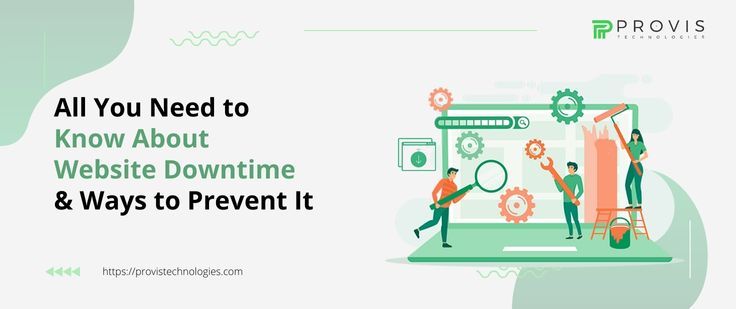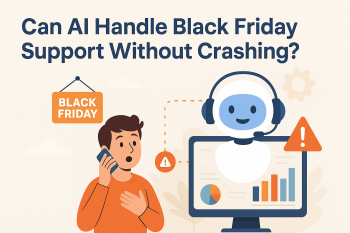Website downtime is when a website becomes inaccessible to visitors. This could be due to technical reasons, cyberattacks, or maintenance activities. Downtimes can severely affect revenue, customer trust, and overall business & reputation.
At its core, website downtimes are more than just a technical glitch. They cause disruption to the entire online business presence. Whether it is an e-commerce platform or a corporate website, every moment of downtime translates to missed opportunities & potential setbacks. Today, we will explore the impacts of website downtime, strategies to prevent it, and last but not least, the benefits of uptime. By understanding website downtime, businesses can better prepare themselves to navigate the digital space with resilience and a more thriving approach.
Stats of Downtime
Before moving forward, let’s check these stats to understand the severity of website downtime.
Cost of Downtime
Website downtime can be financially crippling, with an average cost of $5,600 per minute, according to a study by Gartner.
Frequency of Downtime
On average, websites experience downtime of approximately 3 hours per month, as reported by Statista.
Impact on Revenue
Downtime can result in significant revenue loss, with businesses losing an average of $300,000 per hour of downtime, according to a report by CNBC.
Customer Dissatisfaction
Around 54% of internet users expect websites to load in under 2 seconds, and 79% of dissatisfied customers are less likely to return to a site after experiencing performance issues, as highlighted by Kissmetrics.
Industry Impact
The impact of downtime varies across industries, with the financial sector experiencing the highest average cost of downtime at $10,000 per minute, as reported by Statista.
Don’t Miss:- How to Improve User Experience on Your Website?
Impacts of Downtime
Business Loss
Regardless of duration, website downtime can have far-reaching consequences for businesses & organizations operating in the digital realm. Firstly, and perhaps most significantly, downtime directly affects revenue generation. For e-commerce platforms, every minute of downtime equates to potential sales lost, impacting the bottom line and potentially driving customers to competitors.
Reputation Damage
Moreover, downtime erodes trust among users. In an age where reliability & accessibility are everything, a website’s frequent unavailability can damage its reputation and drive users away. This loss of trust can be particularly detrimental in industries where credibility is essential, such as finance or healthcare.
Workflow Disruption
Beyond financial & reputational impacts, downtime can disrupt internal operations & productivity. Teams reliant on internal systems or databases may be unable to perform critical tasks, leading to delays in workflow.
SEO Impacts
Additionally, downtime impacts search engine rankings and online visibility. Search engines like Google penalize websites that experience frequent downtime, resulting in decreased organic traffic & potential loss of business opportunities.
Must Know:- A Step-by-Step Guide to Website Optimization Strategies for 2024
Ways to Prevent Website Downtime
Preventing website downtime is a critical priority for businesses looking to maintain a top-notch online presence and avoid the potentially devastating consequences of downtime. Fortunately, several key measures can help businesses to minimize the risk of downtime and ensure uninterrupted service for their users.
Invest in Reliable Web Hosting
Investing in reliable web hosting services is essential. Choosing a reputable hosting provider with a track record of high uptime guarantees and robust infrastructure can significantly reduce the likelihood of downtime due to server issues or hardware failures.
Implement Website Monitoring
Implementing website monitoring tools is another effective strategy. These tools continuously monitor website performance and alert administrators if they sense issues or anomalies, enabling prompt intervention and resolution before they escalate into downtime.
Regular Maintenance
Regular maintenance & updates are also crucial for preventing downtime. Keeping software, plugins, and security patches up to date helps mitigate vulnerabilities and minimize the risk of cyber attacks or technical glitches that could disrupt website operations.
Disaster Recovery Plan
A robust disaster recovery plan is essential for organizations to quickly recover from downtime incidents. This plan should include protocols for backup & restoration of data, procedures for communication, and coordination during emergencies.
Content Delivery Network (CDN)
Utilizing CDNs and implementing load-balancing techniques can help distribute website traffic across multiple servers, reducing the risk of overload.
Security Measures
Implement robust cybersecurity measures, such as firewalls, SSL certificates, and intrusion detection systems, to protect against cyber threats. Cyberattacks are one of the reasons for downtime.
Related Blog:- How to Perform a Website Health Check – A Step-by-Step Guide
Benefits of Uptime
While downtime poses significant challenges for businesses, the other side of the coin is uptime – when a website remains accessible & operational. Uptime is not merely the absence of downtime – it represents a successful online presence, which has numerous benefits for businesses.
Better Business
Uptime directly contributes to better business. A website consistently available to users ensures that sales opportunities are not missed, resulting in increased revenue. For e-commerce platforms, maintaining high uptime is particularly crucial during peak shopping periods, as it ensures uninterrupted service to customers.
User Trust
A website that is readily accessible fosters positive interactions with users – leading to higher levels of engagement & repeat business. Positive user experiences also translate into improved brand reputation, as users associate reliability & trustworthiness with a consistently available website.
SEO Ranking
Uptime also contributes to improved search engine rankings and online visibility. Search engines like Google appreciate websites offering uninterrupted user experiences, rewarding them with better rankings in search results. This increased visibility drives organic traffic to the website, further amplifying its reach & potential for growth.
Workflow Betterment
Uptime facilitates smooth workflow & productivity. Teams dependent on internal systems can perform their tasks without interruptions caused by downtime.
Also Read:- Website Performance Metrics Monitoring & Improving User Experience
Bottom Line
Website downtime may cause extreme impacts to businesses, ranging from financial losses to reputational damage. However, with a robust prevention strategy – one can minimize the risk of downtime and ensure uninterrupted access to their websites. By understanding the causes, impacts, and preventive measures outlined in this post – businesses can safeguard their online presence and maintain customer trust in an increasingly competitive digital kingdom.
Moreover, to learn more about website downtime & its preventive measures, website owners can always reach out to web development & maintenance agencies like Provis Technologies. These companies can help you understand the concepts and provide you help & assistance to tackle website issues.
FAQs
What is website downtime?
Website downtime refers to the time period when a website is inaccessible or unavailable to users. It could be due to server issues, maintenance, cyberattacks, or technical glitches.
Why is website downtime a concern?
Website downtime can result in revenue loss, reputation damage, and user distrust. It can also affect your website’s search engine rankings.
How can I prevent website downtime?
You can prevent website downtime by investing in reliable hosting, monitoring your website’s performance, implementing a robust backup system, and using CDNs to distribute traffic.
What are the common causes of website downtime?
Common causes of website downtime include server overload, software glitches, cyber attacks (such as DDoS attacks), hardware failures, and maintenance activities gone wrong.
How frequently should I check my website to prevent downtime?
It’s recommended to regularly monitor your website for downtime using automated tools that can alert you immediately when issues arise. Furthermore, monthly or biweekly manual checks can help ensure everything is okay.
What should I do if my website experiences downtime?
If your website experiences downtime, stay calm and investigate the issue promptly. Check server logs, contact your hosting provider if necessary, and communicate with your users via social media or email to inform them about the situation and estimated resolution time. You can also connect with top IT agencies like Provis Technologies – they can get you help instantly, minimizing the downtime impact.
Written By
Author's Picks
- From Legacy to Modern Updating PHP Versions in Your Maintenance Strategy
- 02/12/2023
- Future Proofing with PHP – Why is Regular Maintenance Essential?
- 26/12/2023
- Issues You Might be Facing with Wix at this point of your Business | Scalability Issues in Wix
- 21/09/2024
Categories
- AI for Startups
- AI in Web Development
- AI Integration
- AI Platforms
- AI Prompt
- AI Tools
- AI Trading Software
- Android App
- Android vs iOS Development
- Angular
- API
- API Development
- App
- app development
- App Idea
- App User Feedback
- Application
- Artificial Intelligence
- Audit Services
- Automotive Industry
- Awards and Recognition
- Business Consulting
- Business Website
- Chatbots
- CRM
- CRM for Financial Advisors
- Custom CRM
- Custom SaaS
- Custom Website
- Customer Service
- dashboard design
- Developing a Mobile App
- Digital Business
- E-commerce
- EMR Integration
- Finance
- Financial Advisors
- Financial Advisors
- GIT
- Health Insurance
- iOS App
- iOS App Development
- IoT Mobile App Development
- IoT Platforms
- IT Audit Services
- IT Consulting
- IT Strategies
- Java Development
- Laravel
- Lean Canvas
- Learning Management System
- Logistics Apps
- Mobile App Development
- MVP
- Native App
- News Aggregator Site
- OTT
- Outsourcing IT
- Payment Gateway
- predictive analysis
- Product Launch Strategy
- Progressive Web App (PWA)
- Prototype
- Recommender Systems
- Ruby
- SaaS
- SaaS Application
- SaaS Business
- SaaS Company
- SaaS Development
- SaaS Product
- SaaS Project
- Sales Funnel
- SEO
- Shopping Cart
- Software Development
- SSL and TLS
- Startup Checklist
- Technology
- Tetradic Color Scheme
- UI/UX Design Company
- Unit Testing
- User Flow
- User Testing
- Web Development
- Web Performance Optimization
- website Maintenance Services
- Website Migration Service
- Website Speed Optimization
- WooCommerce
- WordPress





